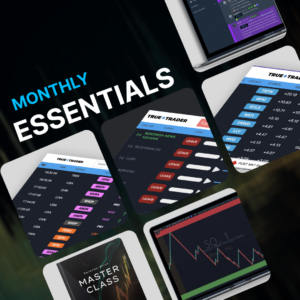How do I become a day trader? Many of the most successful traders will tell people that their trading is a reflection of their inner selves. Everyone has their own individual personality; and therefore has their own trading personality. Part of becoming a day trader requires the individual to “figure themselves out” in order to determine their own trading approach and strategy.
Part of this figuring out involves identifying one’s own risk tolerance. By default, day traders have a high level of risk tolerance. However, how much capital is a trader willing to risk on each trade? Does it vary? What is the risk reward? Where does the trader place his / her stop order? These answers are different for everybody. A well defined system is necessary (without overanalysis) in order to become a successful day trader.
Becoming a day trader requires knowing oneself and either developing or implementing a trading system.
Know Your Products and Trading Vehicles
It is crucial for every day trader to know the products that they are trading! Is a trader going to be trading stocks on margin? Options? Futures? Forex? Futures Options? They are all different and have their own caveats. Stock trading is usually the place where most people start.
Becoming a stock trader requires opening a cash or margin account with a broker. Once an account is set up, traders will have access to equity (stock) products. While many individual stocks trade similarly, many have their own personalities. For example, tech stocks may trade differently than defensive or industrial stocks.
It is wise to get a good understanding of the various stock sectors and understand the different levels of price volatility among different sectors. A 5% move in an underlying small cap stock is much more common and likely than a 5% move in a large cap utility stock on any given day. This is one part of forming a trading plan with proper risk / reward scenarios.
Your Strategy – Know It & Follow It!
This is super important and part of the key to success in trading. Each trader needs to have a regimented and set strategy that is ingrained in their mind. The old adage goes that, traders don’t plan to fail, they fail to plan.
A methodical, calculated and disciplined approach is required to achieve long-term success in trading. Becoming a trader requires following a set system of execution based on strict rule adherence. If it is excitement that one craves, they are best off just going to a casino or racetrack.
Successful day traders follow disciplined instructions based on predetermined entry and exit points based on analysis that has been formed prior to entering a trade. This type of premeditated execution is what is required and must be adhered to while in a trade – emotions cannot be allowed to take over.
The most successful day traders; whether they have learned how to be a day trader at home, or are on the trading desk of a large bank or institution have ice water in their veins and leave their emotions at the door each day.
Technical Analysis
Most day traders employ some level of technical analysis when making their trading decisions. There are many different technical indicators that are used to identify support and resistance, Fibonacci retracements, volume, RSI, MACD, and hundreds if not thousands more. Becoming a day trader will involve learning and understanding some technical indicators. However, it is important not to be using too many different indicators. Over-analysis leads to paralysis. The key is to find a strategy that works for you (without being over complicated) and adhering to the execution of the strategy.
A simpler strategy based on support and resistance may be easier and have better results than another strategy that uses 12 indicators. Most, if not all, day traders are using technical analysis when making trades. When it comes to technical analysis and technical indicators, learn and become familiar with some that you are using in your strategy. Don’t, however, feel that it is crucial to learn and understand every indicator out there.
Capital Requirements – How to Become a Day Trader with Little Money?
Becoming a stock trader can happen with any starting amount of capital. Check with your broker, as some of them may have minimums. Many will have no minimum. However, being under-capitalized can also come with some disadvantages! A trader with a $1,000 account can’t even buy ½ of a share of Amazon at current prices.
Many aspiring traders will ask – How to become a stock trader from home? What amount of money is required to begin? How to become a day trader with little money? This will vary depending on each person’s financial situation, risk tolerance and risk capital. However, being a day trader can be challenging with small accounts because of the PDT – Pattern Day Trade rule. Per FINRA, a Pattern Day Trader, “ includes any margin customer that day trades (buys then sells or sells short then buys the same security on the same day) four or more times in five business days, provided the number of day trades are more than six percent of the customer’s total trading activity for that same five-day period.”.
Once classified as a Pattern Day Trader, a customer must have a minimum of $25,000 equity in their account in order to participate in day trading activities. For traders that have smaller accounts than 25K, they may still day trade, but can only day trade 3 times in a rolling 5 business day period in their margin account. This illustrates one of the challenges with being a day trader with a smaller account.
For traders with smaller accounts, they may find success combining a swing trading approach with their trading; since they cannot day trade as frequently as they may want.
Money Management Principles
This is crucial – and where all the magic happens! Strict money management principles are the key to building a trading bankroll. Some traders employ the one percent rule; risking no more than 1% of their capital on each trade. Others risk more on each trade and decide where to place their stop loss order based on a fixed percentage of the equity in the particular trade or a set percentage of the account balance. Once this is figured out – follow the rules!
Rules are meant to be followed and it is amazing how many traders there are that just cannot follow their own rules! – FOLLOW YOUR RULES! Or, automate them. At minimum, use a stop order so emotions are removed when a losing trade needs to be discarded.
In addition to having a set percentage risked on each trade, a trader needs to know what percentage of their total equity to allocate to each trade. A trader with a 25K account might put on 5 trades at 5K apiece, or maybe 3 trades at 11K apiece (on margin). Trading parameters vary, but be sure to know your plan – and execute it!
Mastering Self Discipline: Being A Day Trader At Home
How to be a day trader from home? TRADING SUCCESS REQUIRES SELF DISCIPLINE. This discipline applies to actual trading discipline and non-trading discipline. The trading plan MUST be followed – without exception! Being a day trader means always adhering to the rules – and not making any one-time exceptions! This cannot be emphasized enough.
A day trader cannot let one bad trade get away from them and have their capital crippled. Many beginning traders ask about how to become a day trader at home. That is part of the allure and one of the benefits – being able to trade from anywhere! In order to become a day trader from home, one must prepare themselves for superior focus and concentration. Put the dogs outside or in another room and make sure everyone else knows you are focusing and cannot be disturbed.
In order to become a day trader, have your plan – and execute it. Know what time of day you will be trading and do nothing else during this time. Being a day trader at home requires mastering self-discipline along with sticking to a consistent, high-probability strategy.
Some Words Of Wisdom About Being A Day Trader
The trend is your friend, my friend.
Trading against the trend is usually not a great idea.
Plan your trade and trade your plan.
Entry, Exit, Stop Loss. Follow your own plan!
Master your own trading personality.
Find what works for you and what you feel comfortable doing.
Don’t add to losing trades.
Unless that is your plan (scaling in), don’t add to a loser.
Use limit orders when you can.
This can help avoid slippage on your order fills.
Don’t overtrade!
Find your opportunities and execute. Sometimes there won’t be a trade – and that’s OK. The market will be there tomorrow morning. Be methodical and have fun with your day trading!


